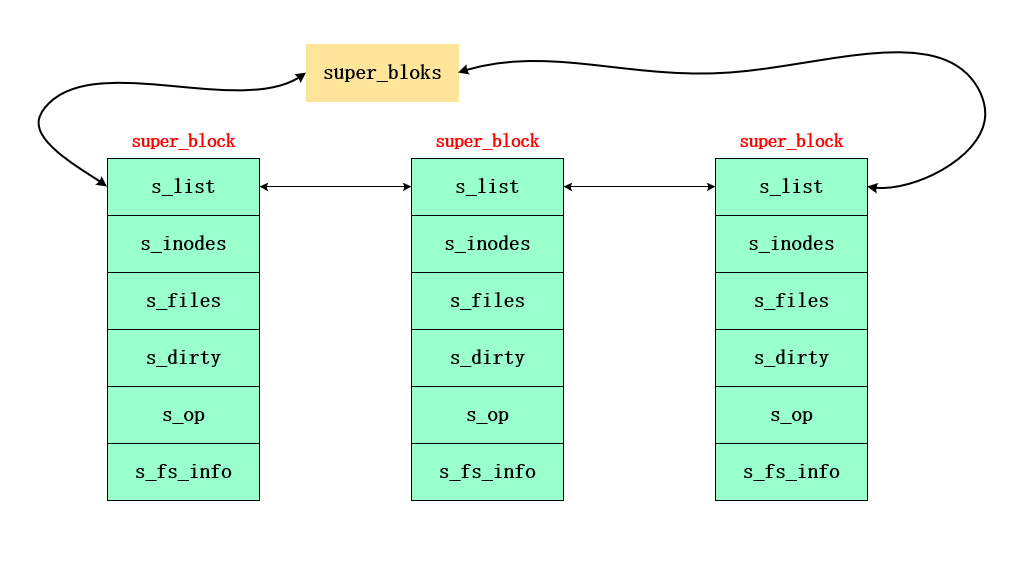转载自:https://blog.csdn.net/wudongxu/article/details/6436894
《Linux内核设计与实现》
http://www.ibm.com/developerworks/cn/linux/l-cn-vfs/
http://www.ibm.com/developerworks/cn/linux/l-linux-filesystem/
http://www.ibm.com/developerworks/cn/linux/l-cn-read/index.html
(1)(文件系统类型)file_system_type:
用于描述具体的文件系统的类型信息,所以被Linux支持的文件系统,都有且仅有一个file_system_type结构而不管它有零个或多个实例被安装到系统中。如ext2,ext3,NFS。
struct file_system_type { const char *name; int fs_flags; #define FS_REQUIRES_DEV 1 #define FS_BINARY_MOUNTDATA 2 #define FS_HAS_SUBTYPE 4 #define FS_USERNS_MOUNT 8 /* Can be mounted by userns root */ #define FS_USERNS_DEV_MOUNT 16 /* A userns mount does not imply MNT_NODEV */ #define FS_RENAME_DOES_D_MOVE 32768 /* FS will handle d_move() during rename() internally. */ struct dentry *(*mount) (struct file_system_type *, int, const char *, void *); void (*kill_sb) (struct super_block *); struct module *owner; struct file_system_type * next; struct hlist_head fs_supers; struct lock_class_key s_lock_key; struct lock_class_key s_umount_key; struct lock_class_key s_vfs_rename_key; struct lock_class_key s_writers_key[SB_FREEZE_LEVELS]; struct lock_class_key i_lock_key; struct lock_class_key i_mutex_key; struct lock_class_key i_mutex_dir_key; };
主要结构体成员说明:
name 文件系统的名字
fs_flags 文件系统类型标志的bitmap(有6种类型)。
mount 在mount文件系统时候,会调用该函数创建suber_block,root_inode等相关信息。
kill_sb 在umount文件系统时候,调用该函数删除suber_block。
owner 指向拥有这个结构的模块,如果一个文件系统被编译进内核,那么该字段为NULL。
next 指向向下一个文件系统类型。
fs_supers 同一种文件类型的超级块形成一个链表,fs_supers是这个链表的头。
(2)超级块对象(super_block):
存储一个已安装的文件系统的控制信息(文件系统的状态、文件系统类型、块大小、区块数、索引节点数、脏标志、操作方法),它代表一个已安装的文件系统;每次一个实际的文件系统被安装时,内核会从磁盘的特定位置(磁盘的超级块位置)读取一些控制信息来填充内存中的超级块对象。一个安装实例和一个超级块对象一一对应。超级块通过其结中的一个域s_type记录它所属的文件系统类型。即使安装了两个相同的文件系统(file_system_type一样)也会有两个超级块(磁盘与内存都有两个)。
struct super_block { struct list_head s_list; /* Keep this first */ dev_t s_dev; /* search index; _not_ kdev_t */ unsigned char s_blocksize_bits; unsigned long s_blocksize; loff_t s_maxbytes; /* Max file size */ struct file_system_type *s_type; const struct super_operations *s_op; const struct dquot_operations *dq_op; const struct quotactl_ops *s_qcop; const struct export_operations *s_export_op; unsigned long s_flags; unsigned long s_magic; struct dentry *s_root; struct rw_semaphore s_umount; int s_count; atomic_t s_active; #ifdef CONFIG_SECURITY void *s_security; #endif const struct xattr_handler **s_xattr; struct list_head s_inodes; /* all inodes */ struct hlist_bl_head s_anon; /* anonymous dentries for (nfs) exporting */ #ifdef CONFIG_SMP struct list_head __percpu *s_files; #else struct list_head s_files; #endif struct list_head s_mounts; /* list of mounts; _not_ for fs use */ /* s_dentry_lru, s_nr_dentry_unused protected by dcache.c lru locks */ struct list_head s_dentry_lru; /* unused dentry lru */ int s_nr_dentry_unused; /* # of dentry on lru */ /* s_inode_lru_lock protects s_inode_lru and s_nr_inodes_unused */ spinlock_t s_inode_lru_lock ____cacheline_aligned_in_smp; struct list_head s_inode_lru; /* unused inode lru */ int s_nr_inodes_unused; /* # of inodes on lru */ struct block_device *s_bdev; struct backing_dev_info *s_bdi; struct mtd_info *s_mtd; struct hlist_node s_instances; struct quota_info s_dquot; /* Diskquota specific options */ struct sb_writers s_writers; char s_id[32]; /* Informational name */ u8 s_uuid[16]; /* UUID */ void *s_fs_info; /* Filesystem private info */ unsigned int s_max_links; fmode_t s_mode; /* Granularity of c/m/atime in ns. Cannot be worse than a second */ u32 s_time_gran; /* * The next field is for VFS *only*. No filesystems have any business * even looking at it. You had been warned. */ struct mutex s_vfs_rename_mutex; /* Kludge */ /* * Filesystem subtype. If non-empty the filesystem type field * in /proc/mounts will be "type.subtype" */ char *s_subtype; /* * Saved mount options for lazy filesystems using * generic_show_options() */ char __rcu *s_options; const struct dentry_operations *s_d_op; /* default d_op for dentries */ /* * Saved pool identifier for cleancache (-1 means none) */ int cleancache_poolid; struct shrinker s_shrink; /* per-sb shrinker handle */ /* Number of inodes with nlink == 0 but still referenced */ atomic_long_t s_remove_count; /* Being remounted read-only */ int s_readonly_remount; };
这个super_block 数据结构十分的巨大,毕竟是包含一个文件系统的重要信息。对我们来说对这个数据结构全部说明,实际上是没有必要的,只要记住一些关键的成员即可。等待实际的开发过程,如果有涉及到的话,再去重点关注即可。
s_list 一个双向循环链表,把系统中所有的文件系统连接起来,一个super_block 在linux的文件系统结构中代表一个文件系统,s_list 包含了linux系统里面所有的文件系统。
dev 设备标识符。
s_blocksize 文件系统块大小
s_blocksize_bits 大小的位数
s_maxbytes 最大文件大小
s_type 文件系统类型
s_op suber_block 的操作集合,例如new_inode 等。
s_flags 文件系统的超级块状态。
s_magic 每一个超级块的唯一魔术标识。
s_root 指向文件系统的根目录的dentry(将在下来的文章中说明)结构体。
s_inodes 所有的这个文件系统的inode结构体都在这个队列上。
s_id[32] 文件系统的名字
s_fs_info 文件系统的私有信息指针,这个指针是非常重要的,它实际是指向下层实际文件系统的结构体。

安装点(vfsmount/mount):当一个文件系统被实际安装,就有一个vfsmount/mount结构体被创建,这个结构体对应一个安装点。与超级块一样(即与超级块是一一对应的),但没有存放在磁盘中。它包括安装点的相关信息,如位置和安装标志等。(早期linux内核版本的安装点只有zfsmount,现在已经将其一拆为二了,具体从哪个版本开始拆题主并没有去查看,题注用的版本是已经拆分完成的)
vfsmount 结构体在include/linux/mount.h
struct vfsmount { struct dentry *mnt_root; /* root of the mounted tree */ struct super_block *mnt_sb; /* pointer to superblock */ int mnt_flags; };
mount 结构体在fs/mount.h文件里面
struct mount { struct list_head mnt_hash; struct mount *mnt_parent; struct dentry *mnt_mountpoint; struct vfsmount mnt; #ifdef CONFIG_SMP struct mnt_pcp __percpu *mnt_pcp; #else int mnt_count; int mnt_writers; #endif struct list_head mnt_mounts; /* list of children, anchored here */ struct list_head mnt_child; /* and going through their mnt_child */ struct list_head mnt_instance; /* mount instance on sb->s_mounts */ const char *mnt_devname; /* Name of device e.g. /dev/dsk/hda1 */ struct list_head mnt_list; struct list_head mnt_expire; /* link in fs-specific expiry list */ struct list_head mnt_share; /* circular list of shared mounts */ struct list_head mnt_slave_list;/* list of slave mounts */ struct list_head mnt_slave; /* slave list entry */ struct mount *mnt_master; /* slave is on master->mnt_slave_list */ struct mnt_namespace *mnt_ns; /* containing namespace */ struct mountpoint *mnt_mp; /* where is it mounted */ #ifdef CONFIG_FSNOTIFY struct hlist_head mnt_fsnotify_marks; __u32 mnt_fsnotify_mask; #endif int mnt_id; /* mount identifier */ int mnt_group_id; /* peer group identifier */ int mnt_expiry_mark; /* true if marked for expiry */ int mnt_pinned; int mnt_ghosts; };
这两个结构体成员注释里面基本说明清楚了,这里就不在做解释了。这里只做一个说明,就是怎么样通过vfsmount 来获取mount。其实也很简单,就是通过内核提供的container_of来获取,具体代码如下
static inline struct mount *real_mount(struct vfsmount *mnt) { return container_of(mnt, struct mount, mnt); }
